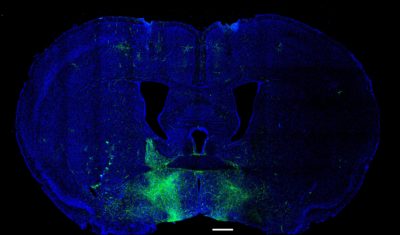Previously unrecognized pathways in mice have relevance for mental health and addiction research
Researchers have identified connections between neurons in brain systems associated with reward, stress, and emotion. Conducted in mice, the new study may help untangle multiple psychiatric conditions, including alcohol use disorder, anxiety disorders, insomnia, and depression in humans.
“Understanding these intricate brain systems will be critical for developing diagnostic and therapeutic tools for a broad array of conditions,” said George F. Koob, Ph.D., director of the National Institute on Alcohol Abuse and Alcoholism (NIAAA), which contributed funding for the study. The National Institute of Mental Health (NIMH) also provided major support for the research. NIAAA and NIMH are parts of the National Institutes of Health.
A report of the study, by first author Dr. William Giardino and colleagues at Stanford University, appears in the August 2018 issue of Nature Neuroscience.
Responding appropriately to aversive or rewarding stimuli is essential for survival. This requires fine-tuned regulation of brain systems that enable rapid responses to changes in the environment, such as those involved in sleep, wakefulness, stress, and reward-seeking. These same brain systems are often dysregulated in addiction and other psychiatric conditions.
In the new study, researchers looked at the extended amygdala, a brain region involved in fear, arousal, and emotional processing and which plays a significant role in drug and alcohol addiction. They focused on a part of this structure known as the bed nucleus of stria terminalis (BNST), which connects the extended amygdala to the hypothalamus, a brain region that regulates sleep, appetite, and body temperature.
The hypothalamus is also thought to promote both negative and positive emotional states. A better understanding of how the BNST and hypothalamus work to coordinate emotion-related behavior could shed light on the emotional processes dysregulated in addiction.
“These circuits, also implicated in binge drinking, are likely to be elements in understanding the detailed mechanisms driving stress-related alcohol- or drug-seeking and consummatory behaviors,” said first author Dr. Giardino.
To map the brain circuitry between the BNST and the hypothalamus, Dr. Giardino and his colleagues exposed mice to rewarding and aversive stimuli, and then visualized and manipulated the activity of neurons using fiber optic techniques.
The scientists identified two distinct subpopulations of neurons in the BNST that connect to separate populations of neurons in the lateral hypothalamus. These parallel circuits drove opposing emotional states: avoidance (aversion) and approach (preference). Different neurotransmitters were linked to aversion and preference within these neurocircuits – corticotropin releasing factor was involved in aversion, while cholecystokinin played a role in preference.
“The discovery of the unique and opposing influences of these specific BNST to LH circuits may be broadly relevant to the fields of neuroscience and mental health,” said senior author Luis de Lecea, Ph.D., Professor of Psychiatry and Behavioral Sciences at Stanford University.
The authors note that future studies of the BNST to LH pathways will inform the development of improved therapeutic approaches for psychiatric disorders.
Citation:
Giardino WJ, Eban-Rothschild A, Christoffel DJ, Li SB, Malenka RC, de Lecea L (2018). Parallel circuits from the bed nuclei of stria terminalis to the lateral hypothalamus drive opposing emotional states. Nature Neurosci. (21)1084–1095.
This press release describes a basic research finding. Basic research increases our understanding of human behavior and biology, which is foundational to advancing new and better ways to prevent, diagnose, and treat disease. Science is an unpredictable and incremental process— each research advance builds on past discoveries, often in unexpected ways. Most clinical advances would not be possible without the knowledge of fundamental basic research.
About the National Institute on Alcohol Abuse and Alcoholism (NIAAA):
The National Institute on Alcohol Abuse and Alcoholism (NIAAA), part of the National Institutes of Health, is the primary U.S. agency for conducting and supporting research on the causes, consequences, diagnosis, prevention, and treatment of alcohol use disorder. NIAAA also disseminates research findings to general, professional, and academic audiences. Additional alcohol research information and publications are available at https://www.niaaa.nih.gov/.
About the National Institutes of Health (NIH):
NIH, the nation’s medical research agency, includes 27 Institutes and Centers and is a component of the U.S. Department of Health and Human Services. NIH is the primary federal agency conducting and supporting basic, clinical, and translational medical research, and is investigating the causes, treatments, and cures for both common and rare diseases. For more information about NIH and its programs, visit www.nih.gov.
